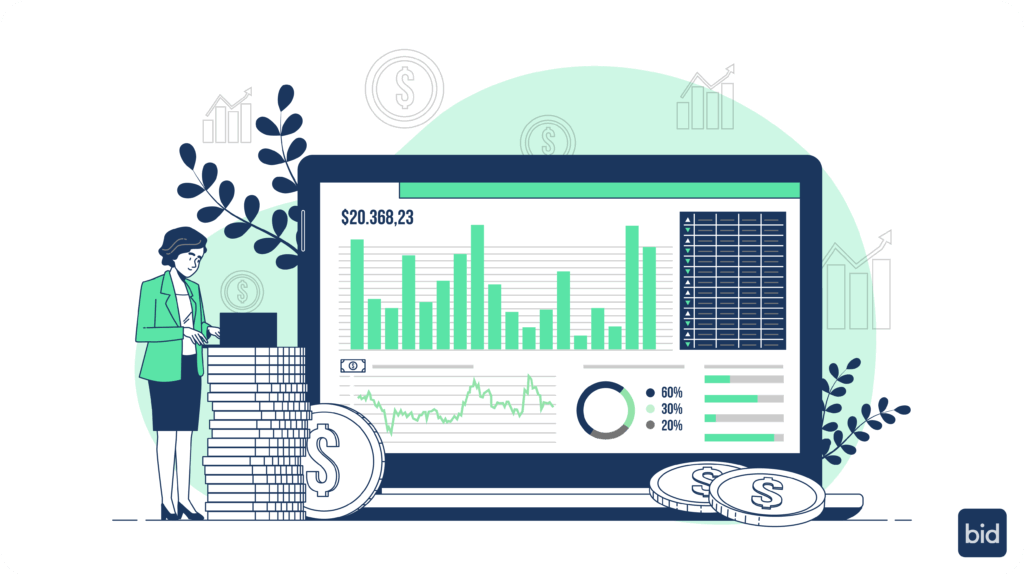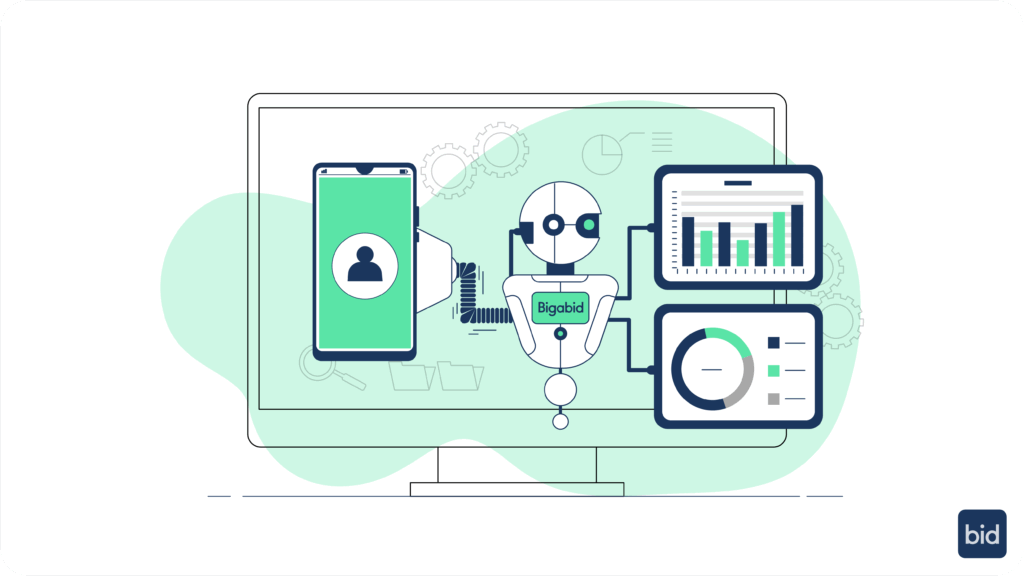
Mobile app advertising happens at a speed that’s almost impossible to comprehend. Every time someone opens their phone, thousands of advertisers compete in real-time auctions to show them ads. These auctions happen in the time it takes to blink—often in under 100 milliseconds.
But here’s what most mobile app marketers don’t realize: while they’re optimizing campaigns manually over days or weeks, neural networks are making thousands of micro-optimizations every second during these auctions. The difference between winning profitable bids and losing to competitors often comes down to algorithms that can process massive amounts of data faster than human thought.
Traditional programmatic bidding relies on simple rules and historical averages. Neural networks take a completely different approach, analyzing hundreds of variables in real-time to calculate the exact value of each impression and bid accordingly.
This isn’t just about speed—it’s about intelligence at scale. Neural networks can identify patterns in user behavior, predict conversion likelihood, and adjust bidding strategies on the fly in ways that manual optimization simply can’t match.

Mobile app programmatic auctions operate on timescales that challenge human comprehension. When someone launches a mobile app or opens a mobile website, dozens of ad exchanges simultaneously broadcast bid requests to hundreds of demand-side platforms.
These bid requests contain crucial information: device type, location data, app category, user demographics, and behavioral signals. But there’s a catch—advertisers have roughly 100 milliseconds to analyze this data, calculate bid value, and submit their response.
Miss that deadline? The auction moves on without you. Submit a bid that’s too low? A competitor wins the impression. Bid too high? You overpay and destroy campaign profitability.
Traditional programmatic systems handle this challenge with predetermined rules and lookup tables. If the user fits demographic X in location Y, bid amount Z. These systems work at the required speed but miss the nuanced optimization opportunities that separate profitable campaigns from budget waste.
The volume makes manual optimization impossible. Popular mobile apps generate millions of bid opportunities daily. Even the most dedicated human optimizer couldn’t manually evaluate and price individual impressions at this scale.
Platform algorithms add another layer of complexity. Google, Facebook, and other major players use their own machine learning systems to optimize ad delivery. Advertisers who bid more intelligently often receive preferential treatment in future auctions.
User behavior patterns shift constantly throughout the day, week, and season. Morning commuters behave differently than evening entertainment seekers. Weekend shopping patterns differ from weekday browsing. Static bidding rules can’t adapt to these variations in real-time.

Neural networks transform programmatic bidding from reactive rule-following to predictive intelligence that operates at machine speed.
These systems process bid request data through multiple layers of analysis simultaneously. User demographics get cross-referenced with behavioral patterns. Location data combines with time-of-day signals. Device characteristics merge with app category preferences. All of this happens in parallel, not sequentially.
Real-time user scoring represents the core breakthrough. Instead of broad demographic targeting, neural networks calculate individual user value based on hundreds of behavioral signals. Someone who frequently downloads gaming apps, makes in-app purchases, and engages with video content receives a different score than casual browsers.
Contextual analysis extends beyond basic targeting to understand the environment surrounding each bid opportunity. Neural networks recognize that the same user might have completely different conversion probability depending on time of day, current location, or recent app usage patterns.
Competitive intelligence operates at auction level. Neural networks track bidding patterns from other advertisers and adjust strategies accordingly. If competitors consistently bid aggressively for certain user segments, the system might identify undervalued audiences where competition is lighter.
Dynamic pricing calculations happen in real-time based on campaign performance data. Instead of fixed cost-per-install targets, neural networks adjust bidding based on predicted user lifetime value, current campaign pacing, and budget optimization goals.
Learning loops operate continuously. Every auction result—whether won or lost—provides training data that improves future bidding decisions. Winning a bid for a user who converts validates the value calculation. Losing a bid for a high-value user triggers strategy adjustment.

The technical architecture required for neural network-powered bidding operates at a scale and speed that pushes computational limits.
Edge computing brings decision-making closer to auction environments. Instead of sending bid requests to centralized servers, neural networks operate on distributed infrastructure that reduces latency and improves response times.
Parallel processing systems analyze multiple aspects of each bid request simultaneously. While one neural network evaluates user value, another assesses competitive dynamics, and a third calculates optimal bid price. These parallel analyses combine into final bidding decisions.
Real-time data pipelines feed fresh information into bidding algorithms continuously. User behavior data, campaign performance metrics, and market conditions update neural network models without interrupting auction participation.
Predictive caching anticipates likely bid scenarios and pre-calculates responses for common user profiles and contexts. This approach reduces processing time during actual auctions while maintaining bidding precision.
Failover systems ensure auction participation continues even when primary neural networks experience issues. Backup algorithms maintain bidding activity while primary systems recover, preventing complete campaign disruption.
Model versioning enables continuous improvement without service interruption. Neural networks update their algorithms and parameters while maintaining auction participation, allowing for gradual improvement without downtime.

Neural network bidding strategies extend far beyond simple cost optimization to encompass sophisticated campaign management at auction speed.
User quality prediction identifies valuable prospects before they convert. Instead of bidding uniformly for all users in a demographic segment, neural networks identify individuals with high conversion probability and adjust bids accordingly.
Budget pacing algorithms distribute spend optimally throughout campaign periods. Rather than burning through budgets quickly or underspending targets, neural networks pace bid aggressiveness to hit performance goals while maximizing volume.
Cross-campaign optimization coordinates bidding across multiple mobile app campaigns simultaneously. Neural networks recognize when the same user might be valuable for different campaigns and allocate bids to maximize overall portfolio performance.
Seasonal and temporal adjustments adapt bidding strategies to time-based patterns automatically. Neural networks recognize that fitness app users behave differently in January than July and adjust bidding strategies accordingly without manual intervention.
Platform-specific optimization tailors bidding approaches to individual advertising platforms and their unique auction dynamics. Google’s auction algorithms differ from Facebook’s, requiring different neural network strategies for optimal performance.
Creative performance integration considers ad creative quality when calculating bid values. High-performing creative assets justify higher bids, while poor-performing creative reduces optimal bid levels.

Neural network bidding delivers measurable improvements across key performance metrics that mobile app marketers track.
Cost efficiency gains emerge from more precise bid pricing that reduces overpayment while maintaining competitive win rates. Neural networks identify the minimum bid required to win valuable impressions rather than relying on broad bidding strategies.
User quality improvements result from better targeting precision that attracts users more likely to engage with mobile apps long-term. Neural networks identify subtle behavioral patterns that correlate with user retention and lifetime value.
Scale optimization enables campaign volume growth without proportional performance degradation. Neural networks maintain bidding precision even as campaign spend increases, avoiding the quality-versus-volume tradeoffs common in traditional programmatic advertising.
Attribution accuracy improves as neural networks track user journeys across multiple touchpoints and attribute value accordingly. This enhanced attribution enables more sophisticated bidding strategies based on complete user value rather than last-click conversions.
Competitive positioning strengthens as neural networks identify market opportunities and competitive gaps that manual optimization might miss. Faster adaptation to market changes provides sustainable competitive advantages.
Campaign management efficiency increases as neural networks handle routine optimization tasks, allowing marketing teams to focus on strategic decisions rather than tactical bid adjustments.

Successfully implementing neural network bidding requires strategic planning that addresses both technical requirements and campaign management workflows.
Data integration becomes crucial for neural network performance. Clean, comprehensive user behavior data enables more accurate bidding decisions, while incomplete or inconsistent data limits optimization potential.
Campaign structure optimization ensures neural networks have sufficient volume and diversity to identify meaningful patterns. Overly narrow campaigns might not provide enough data for effective learning, while overly broad campaigns might dilute optimization focus.
Performance measurement frameworks need adjustment to capture neural network bidding benefits. Traditional metrics should be supplemented with efficiency indicators like bid accuracy, win rate optimization, and user quality scoring.
Budget allocation strategies must account for neural network learning periods. These systems often show gradual improvement as they accumulate performance data and refine their algorithms.
Platform coordination becomes important as neural networks operate across multiple advertising platforms with different auction dynamics and optimization requirements.
Testing methodologies require modification to evaluate neural network performance effectively. Traditional A/B testing approaches might miss subtle but significant improvements that accumulate over time.

Neural network bidding continues evolving toward even more sophisticated optimization capabilities that promise enhanced performance for mobile app marketers.
Cross-device bidding will enable neural networks to recognize the same user across multiple devices and optimize bidding strategies accordingly. This unified approach improves attribution accuracy and bidding precision.
Predictive audience modeling will anticipate user behavior changes before they occur, enabling proactive bidding strategy adjustments that maintain campaign performance during market shifts.
Real-time creative optimization will coordinate bidding decisions with creative performance to maximize both reach and engagement simultaneously.
Privacy-compliant targeting will maintain bidding precision while operating within evolving privacy regulations and platform policy changes.
Advanced attribution modeling will enable neural networks to optimize for complex user journeys that span multiple sessions, devices, and timeframes.

Neural network bidding represents a fundamental shift from reactive campaign management to proactive optimization that operates at machine speed and scale.
Mobile app marketers implementing these technologies gain significant competitive advantages through improved efficiency, better user quality, and enhanced campaign performance. The technology becomes increasingly essential as auction complexity grows and competition intensifies.
Bigabid’s neural network platform operates at the speed and scale required for modern programmatic auctions, processing hundreds of variables in microseconds to optimize bidding decisions for mobile app campaigns.
The platform transforms auction participation from simple rule-following to intelligent decision-making that adapts continuously to market conditions, user behavior patterns, and campaign performance data.
Contact Bigabid to learn how neural network bidding can transform mobile app advertising performance through intelligent auction participation and real-time optimization.